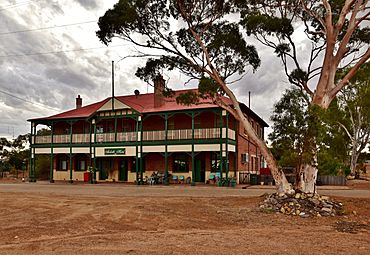Ardath, Western Australia facts for kids
Quick facts for kids ArdathWestern Australia |
|
|---|---|

Ardath Hotel, 2018
|
|
| Established | 1914 |
| Postcode(s) | 6419 |
| Elevation | 219 m (719 ft) |
| Area | [convert: needs a number] |
| Location |
|
| LGA(s) | Shire of Bruce Rock |
| State electorate(s) | Central Wheatbelt |
| Federal Division(s) | O'Connor |
Ardath is a small town located in the Wheatbelt region of Western Australia. It is about 20 kilometers (12 miles) south of the town of Bruce Rock. Ardath was established to support the railway line that connected Corrigin to Bruce Rock.
Contents
Ardath: A Brief History
Ardath was first established in April 1914. Its original name was Kerkenin. However, people often confused it with another town called Kukerin. To avoid this mix-up, the town's name was changed to Ardath. This new name came from a prophet mentioned in an old religious text called 2 Esdras.
Farming and Grain in Ardath
The land around Ardath is very important for farming. Farmers in this area grow a lot of wheat and other cereal crops. These crops are a major part of the local economy.
How Grain is Stored
Ardath is a special place where farmers can deliver their harvested grain. It is a "receival site" for a company called Cooperative Bulk Handling. This company helps farmers store and transport their crops.
In 1932, the Wheat Pool of Western Australia decided to build two large structures in Ardath. These were called grain elevators. They were designed to lift and store grain from railway cars. Each elevator had its own engine to help with this work.
A very large storage bin for wheat was built in Ardath and opened in December 1940. In its first season, this bin received a huge amount of wheat. It collected over 203,000 bushels of grain. On one busy day, it even received 242 tons of wheat!
Ardath's Role in World War II
During World War II, Ardath played a small but important role. In 1942, a military site was set up here. It was called No. 9 Advanced Ammunition sub depot. This was a place where ammunition (like bullets and shells) was stored safely.
Military Operations
The depot was managed by a group of soldiers called the 16 Ordnance Ammunition Section. They were responsible for keeping the ammunition secure. This military site operated for a few years during the war. It was eventually closed down in 1945, after the war ended.


